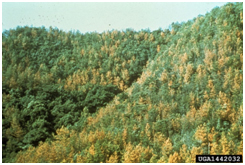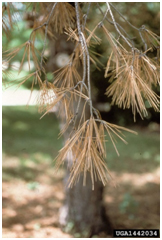
The Pine wilt nematode is a microscopic unsegmented worm that affects firs, cedars, larches, spruces, and especially pines. It is unlikely to affect Australian native trees, but it would be damaging to Australia’s forestry industry and amenity trees.
Pine wilt nematode is indigenous to North America (USA, Mexico and Canada), but has been introduced to Japan, Korea, China, and Taiwan, South Africa, Portugal and Spain. Eradication contingency plans have been developed for the European Union and have highlighted that extreme measures would need to be undertaken. Pine wilt nematode is considered a severe pest that has been estimated to have caused losses of greater than 2 million cubic metre of wood per year in the USA.
The nematode can live freely in host trees and also in soil. While some spread is possible through the movement of soil or contact between infested wood, the main mechanism for spread is via the Japanese sawyer beetle and other species of Monochamus longhorn beetle. The life cycle of the pine wilt nematode has a propagative cycle (from egg to adult) during which nematode larvae aggregate in the pupal chamber of the Japanese sawyer beetle. They enter the respiratory system of the young adult beetle and when the beetle emerges from the tree the nematodes are carried to new hosts (the dispersal cycle). Pine sawyer beetles can transmit the nematode by way of the wounds they make when feeding on the bark of young branches. They also transmit the nematode when they lay their eggs in weakened trees or in logs with attached bark.
 What it looks like
What it looks like
Mature pine wilt nematodes are about 1 millimetre in length. After infesting a host tree, pine wilt nematodes reproduce rapidly and feed on cells in the resin ducts within the tree. The damage caused by nematodes prevents water movement within the tree and reduces resin production. Depending on the site of infestation, this may show up as wilting on a single branch, called a ‘flag’, or across a whole tree. Over time the damaging effects will eventually lead to death of the tree. These trees are attractive to the adult Monochamus beetles which gather on the trunks to mate.
What to look for and where
Due to its size, pine wilt nematode is very difficult to detect by the naked eye. However, the effects of the pinewood nematode on host trees are marked. It is these symptoms that are the most obvious signs that pine wilt nematode may be present. Characteristic flagging within a tree or apparently random wilting of trees within a plantation may be a sign that pine wilt nematode is present.
More information
Data Sheets on Quarantine Pests- Bursaphelenchus xylophilus
